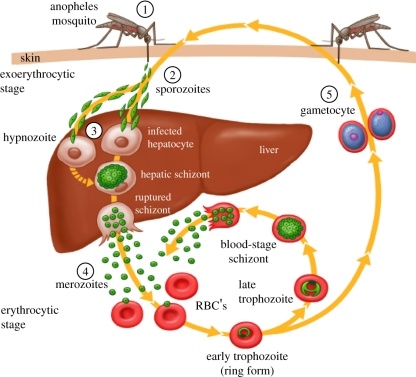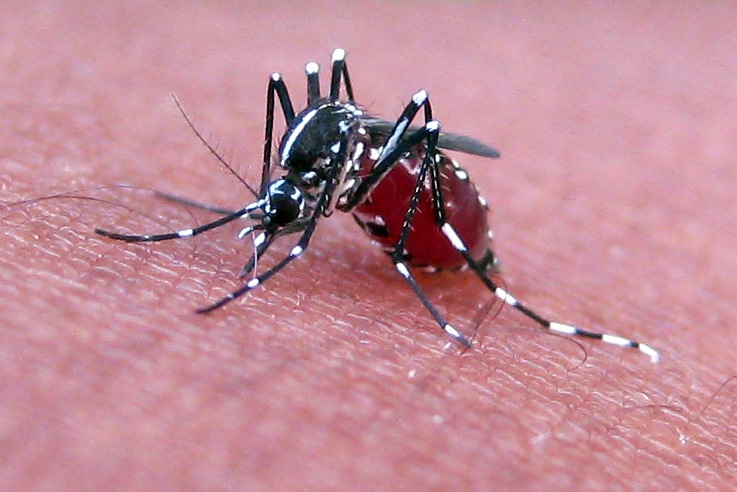Mosquitos have often been referred to as the ‘deadliest’ animals on the planet, responsible for the deaths of millions worldwide. Aside from leaving behind itchy, red bumps after taking a blood meal, they are carriers of several serious diseases, including chikungunya, yellow fever, Zika and Dengue (transmitted by Aedes mosquitos), Malaria (transmitted by Anopheles mosquitos) and the West Nile virus (primarily transmitted by the Culex mosquitos).
These diseases occur when a mosquito takes a blood meal from an individual (human or animal host) infected with a virus or parasite. When the mosquito bites, it ‘sucks’ the blood of the individual, whilst at the same time secreting saliva back into their bloodstream. Having been transferred from the host to the mosquito vector, the virus circulates in the mosquito’s body, eventually accumulating in the salivary glands. The next time that mosquito takes a blood meal, they will pass the virus onto the individual through the secretion of saliva into the bloodstream.

Although mosquito control measures have greatly improved over the past decade, mosquito-borne disease is still a massive concern. Not only do they cause social and economic problems for both individuals and governments, but they also pose significant risks to human health. According to the CDC (Centre for Disease Control and Prevention), up to 400 million people a year are infected with Dengue alone, and in 2019 an estimated 409 thousand people died of Malaria.
Over the years, education about these diseases have dramatically improved, such that individuals can take a number of precautions to protect themselves and their families from mosquitos. These precautions include using pesticides/insecticides, removing standing bodies of water (where mosquito larvae are usually found), and using bed nets to prevent bites during the night.
Alongside these precautions, scientists and researchers working in laboratory conditions have developed multiple ways to try and control the mosquitos. Past methods include irradiation of mosquitos to make males infertile, genetically modifying mosquitos (either through self-limiting genes or fluorescent marker genes) so females do not live to adulthood, or by infecting mosquitos with Wolbachia, a bacterium which has shown to reduce their vector competency (i.e., mosquitos infected with Wolbachia are less capable of transmitting a virus).
More recently, researchers at Imperial College London (ICL) have developed a method of mosquito-control which uses gene drives which make the female mosquitos infertile. A ‘gene drive’ is a natural process through which the frequency of a particular genetic trait is increased by altering the probability that the trait will pass from parent to offspring. Thanks to the development of CRISPR gene-editing technology, scientists are able to use this gene-drive mechanism to select and ensure the frequency of a particular gene within a population.
In this study, the geneticists designed a gene drive which specifically targets ‘doublesex’ – a gene which regulates sex determination in insects. This causes the female mosquitos to display ‘female-male sexual development (intersex’) and means they cannot produce offspring. Using this method, the scientists say they were able to achieve ‘complete’ population suppression within 560 days of beginning the experiment. Gene drives are prone to spreading rapidly through populations, and it is hoped that by releasing modified males into the environment, the number of mosquitos will be reduced due to the spread of this female infertility mutation.
So far, the research has only been conducted with Anopheles gambiae mosquitos (principal vectors of malaria). However, using this same technique it is possible that this technology could eventually be used to eliminate entire, and every, species of mosquito that exists.
The important question is, should we?
Despite the irritating buzzing and the health threats they pose, wiping mosquitos from the planet may actually cause more environmental harm than good. There are over 3,000 species of mosquito found across the planet, most of which are completely harmless and do not feed on human or animal blood. The species that do amount to as little as 6% (around 100 species) out of the total number of species on the planet. Even then, out of these 100 species, it is only the females of each species that must take a blood meal, to obtain protein for her offspring. Some species of mosquito are pollinators, feeding on nectar and transferring pollen from flower to flower.
Mosquitos also play an important role in the ecosystem. Mosquito larva (found in stagnant water pools) as well as adult mosquitos, are important food sources for several bird, fish and other insect species, whose populations could suffer as a result of losing this food source. The larvae feed on micro-organisms (such as algae, microbes and fungus) in order to grow. When mosquitos die (or are eaten and then excreted) the microbes they consumed as larva are returned to the ecosystem and provide important nutrients for plant growth.
Mosquitos, at least those few mosquito species that act as disease vectors, pose an undeniable threat to human health and livelihood. However, when considering whether to eliminate entire species of mosquito from the face of the planet, it is important to remember the ‘secret life’ of mosquitos, and how they fit into our ecosystem. Ideally, we want to protect humans and prevent the spread of diseases that claim the lives of millions each year but do so whilst also keeping the ecological function of mosquitos intact. Research, such as that being conducted in the labs at ICL, is essential in order to reduce the fatality rate due to mosquito-borne diseases. By targeting specific species of mosquito, rather than using non-species-specific methods (I.e., by using pesticides or bed nets), we can protect harmless species of mosquito that play important roles in pollination and food chains, whilst at the same time reducing the risk to human health by removing the ability of mosquitos to transmit a disease, through induced infertility, reduced their ability to carry the virus/parasite or by limiting lifespan so females do not reach adulthood.

